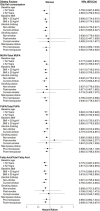Effects of oily fish and its fatty acid intake on non-alcoholic fatty liver disease development among South Korean adults
- PMID: 35938102
- PMCID: PMC9353947
- DOI: 10.3389/fnut.2022.876909
Effects of oily fish and its fatty acid intake on non-alcoholic fatty liver disease development among South Korean adults
Abstract
Background: The benefits of fish fatty acid intake for non-alcoholic fatty liver disease (NAFLD) are rarely reported, although a previous study assessed the relationship between oily fish consumption and the prevalence of NAFLD.
Aims: We investigated whether oily fish and fish-based monounsaturated fatty acids, polyunsaturated fatty acids, and omega-3 fatty acids affect the development of NAFLD in South Korean adults.
Methods: In this large-scale cohort study, 44,139 participants of the Health Examinees study were selected for analysis after 5 years of follow-up. NAFLD is diagnosed with a non-invasive index, the fatty liver index. Using multivariable Cox proportional hazards models, adjusted for age, body mass index, total energy intake, education, physical activity, smoking status, and drinking (alcohol) status, we calculated the hazard ratios and 95% confidence intervals.
Results: For men, NAFLD had no statistically significant associations with quartiles of total oily fish or its fatty acid intake. However, among women, an inverse association was observed (all p for trend <0.05). Regarding the standard deviation (SD) increment of total oily fish or its fatty acid intake by one, all fatty acids from oily fish showed inverse associations for NAFLD in both men and women. After stratified analyses, we found that drinking status and menopause status were independent risk factors for NAFLD. Oily fish or its fatty acid intake has the same benefit pattern on metabolic dysfunction-associated fatty liver disease as NAFLD.
Conclusion: Oily fish and its fatty acid intake showed a preventative benefit for NAFLD and metabolic dysfunction-associated fatty liver disease, especially in South Korean women.
Keywords: South Korean adults; cohort study (or longitudinal study); non-alcoholic fatty liver disease – NAFLD; oily fish consumption; omega-3 fatty acid.
Copyright © 2022 Tan and Shin.
Conflict of interest statement
The authors declare that the research was conducted in the absence of any commercial or financial relationships that could be construed as a potential conflict of interest.
Figures


Similar articles
-
Association of fish and meat consumption with non-alcoholic fatty liver disease: Guangzhou Biobank Cohort Study.BMC Public Health. 2023 Dec 6;23(1):2433. doi: 10.1186/s12889-023-17398-6. BMC Public Health. 2023. PMID: 38057730 Free PMC article.
-
Dietary sodium and potassium intake in relation to non-alcoholic fatty liver disease.Br J Nutr. 2016 Oct;116(8):1447-1456. doi: 10.1017/S0007114516003391. Epub 2016 Oct 11. Br J Nutr. 2016. PMID: 27725000
-
Dairy protein intake is inversely related to development of non-alcoholic fatty liver disease.Clin Nutr. 2021 Oct;40(10):5252-5260. doi: 10.1016/j.clnu.2021.08.012. Epub 2021 Aug 25. Clin Nutr. 2021. PMID: 34534894
-
Ultra-processed food consumption and the risk of non-alcoholic fatty liver disease in the Tianjin Chronic Low-grade Systemic Inflammation and Health Cohort Study.Int J Epidemiol. 2022 Feb 18;51(1):237-249. doi: 10.1093/ije/dyab174. Int J Epidemiol. 2022. PMID: 34528679
-
Omega-3 fatty acids: Mechanisms of benefit and therapeutic effects in pediatric and adult NAFLD.Crit Rev Clin Lab Sci. 2016;53(2):106-20. doi: 10.3109/10408363.2015.1092106. Epub 2015 Oct 14. Crit Rev Clin Lab Sci. 2016. PMID: 26463349 Review.
Cited by
-
Fish consumption benefits and PFAS risks: Epidemiology and public health recommendations.Toxicol Rep. 2024 Sep 19;13:101736. doi: 10.1016/j.toxrep.2024.101736. eCollection 2024 Dec. Toxicol Rep. 2024. PMID: 39391711 Free PMC article. Review.
-
Meat and fish consumption, genetic risk and risk of severe metabolic-associated fatty liver disease: a prospective cohort of 487,875 individuals.Nutr J. 2025 Apr 25;24(1):65. doi: 10.1186/s12937-025-01134-4. Nutr J. 2025. PMID: 40281620 Free PMC article.
-
Association of depression with severe non-alcoholic fatty liver disease: evidence from the UK Biobank study and Mendelian randomization analysis.Sci Rep. 2024 Nov 19;14(1):28561. doi: 10.1038/s41598-024-79100-z. Sci Rep. 2024. PMID: 39557910 Free PMC article.
-
Association of the habitual dietary intake with the fatty liver index and effect modification by metabotypes in the population-based KORA-Fit study.Lipids Health Dis. 2024 Apr 4;23(1):99. doi: 10.1186/s12944-024-02094-0. Lipids Health Dis. 2024. PMID: 38575962 Free PMC article.
-
Causal associations between dietary habits and liver cancer risk: a two-sample Mendelian randomization study.Discov Oncol. 2025 Feb 5;16(1):120. doi: 10.1007/s12672-025-01885-w. Discov Oncol. 2025. PMID: 39909996 Free PMC article.
References
-
- Loomba R, Sanyal AJ. The global NAFLD epidemic. Nat Rev Gastroenterol Hepatol. (2013) 10:686–90. - PubMed
-
- Allard JP, Aghdassi E, Mohammed S, Raman M, Avand G, Arendt BM, et al. Nutritional assessment and hepatic fatty acid composition in non-alcoholic fatty liver disease (NAFLD): a cross-sectional study. J Hepatol. (2008) 48:300–7. - PubMed
-
- Cortez-Pinto H, de Moura MC, Day CP. Non-alcoholic steatohepatitis: from cell biology to clinical practice. J Hepatol. (2006) 44:197–208. - PubMed
-
- Byrne CD, Targher G. NAFLD: a multisystem disease. J Hepatol. (2015) 62(Suppl. 1):S47–64. - PubMed
LinkOut - more resources
Full Text Sources

